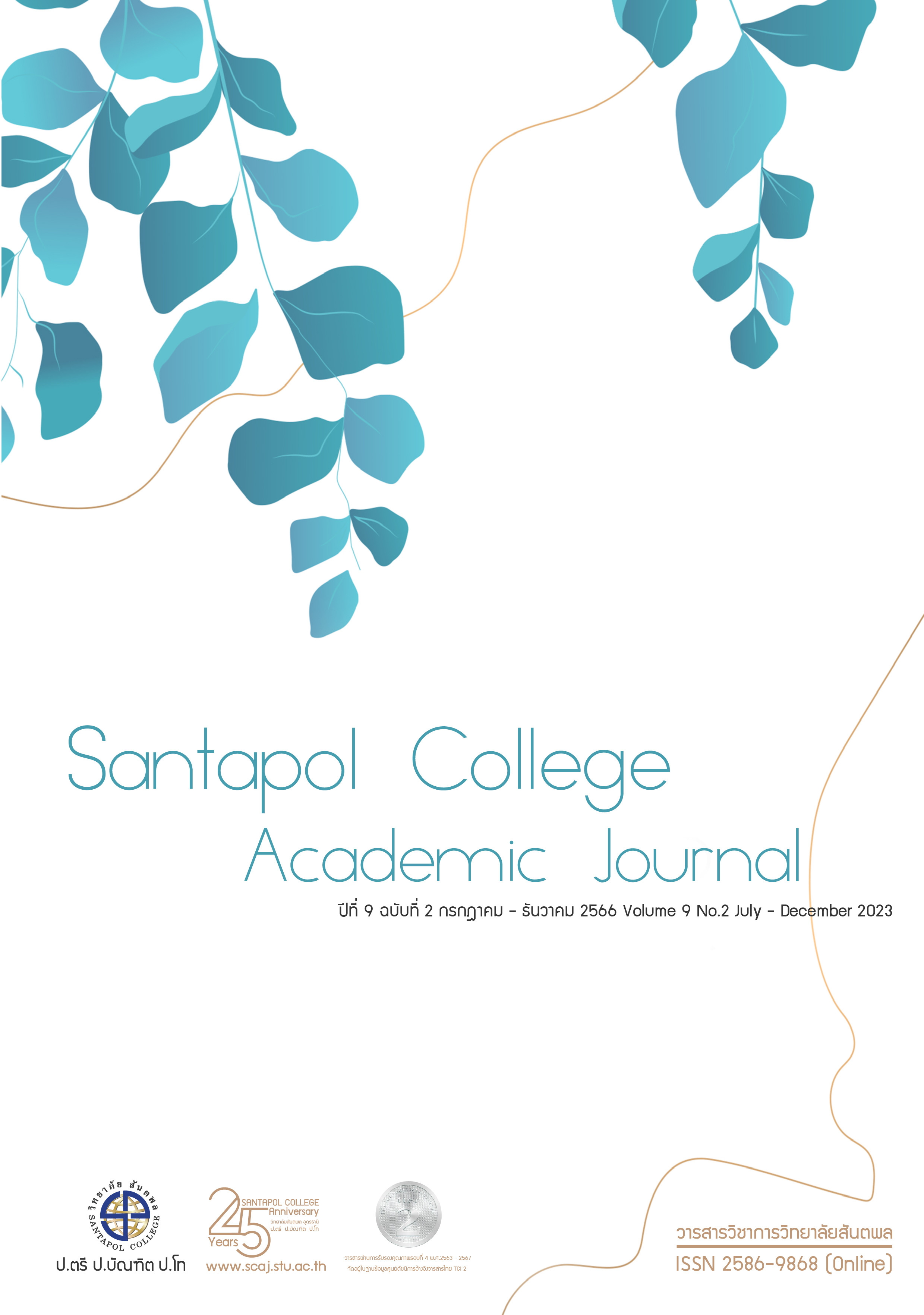THE CREATION AND DESIGN OF PHA KIT YOK DOK PATTERN IN PHETCHABUN PROVINCE USING MATHEMATICS PROGRAM
Main Article Content
Abstract
The purpose of this study is to 1) study and design Khit Yok Dok pattern in Phetchabun Province using Geometer's Sketchpad program : GSP 2) study the satisfaction towards the design of Khit Yok Dok fabric using GSP program and 3) transfer the knowledge of Khit Yok Dok fabric design using GSP program. Yok Kid" Village No. 5, Ban Wang Rong, Huai Rai Sub-district, Lom Sak District, Phetchabun Province, totaling 17 people and first-year students in Mathematics and Computational Science. There were 11 students enrolled in MATH503 Euclidean Geometry, Semester 1, Academic Year 2022, and 3 expert, a totaling 31 people The tools used were 1) a questionnaire for fabric pattern specialists. and using the GSP program. 2) a questionnaire on the satisfaction of the subjects towards the method of weaving Khit weaving with 4 different styles of weaving; with the design of the Khit Yok Dok fabric pattern with the GSP program
The findings are as follows: 1) the Experts were satisfied with the design and suitability for weaving into fabric patterns at a high level for both patterns. Considering the satisfaction of each design, the second pattern has elements of the fabric pattern according to the design theory and consistent with Thai identity more than pattern 1. 2) As a whole, the members of "Hong Huok Yok Kit were highly satisfied with the pattern designs developed by weaving Khit Yok Dok which are 4 different styles; namely, weaving patterns: type 2, type 3, type 1. and type 4, respectively. And 3) As a whole, the trainees reveal that the transmission of the knowledge toward the designed of Pha Kit Yok Dok Pattern by GSP program is worthwhile. They are satisfied with all items of the outreach program. The first 2 satisfactory items are the trainees are able to use the GSP program for designing of Pha Kit Yok Dok Pattern and Confidence in applying the knowledge gained. In terms of training quality, as a whole, is at the highest satisfactory. The items at the highest level were those who had techniques for transferring knowledge and at the highest level, followed by the availability of audio-visual equipment and the ability to apply the knowledge gained after training, respectively.
Article Details

This work is licensed under a Creative Commons Attribution-NonCommercial-NoDerivatives 4.0 International License.
เนื้อหาและข้อมูลในบทความที่ลงตีพิมพ์ในวารสารวิชาการวิทยาลัยสันตพล ถือว่าเป็นข้อคิดเห็นและความรับผิดชอบของผู้เขียนบทความโดยตรง ซึ่งกองบรรณาธิการวารสารไม่จำเป็นต้องเห็นด้วยหรือรับผิดชอบใดๆ
References
ชูศักดิ์ ยาทองไชย และ วิไลรัตน์ ยาทองไชย. (2565). การพัฒนาออกแบบลายผ้าเพื่อการสร้างสรรค์และสืบสานภูมิปัญญาผ้าไทย. วารสารหน่วยวิจัยวิทยาสาสตร์ เทคโนโลยี และสิ่งแวดล้อมเพื่อการเรียนรู้, 13(2), 198-212.
พิพิธภัณฑ์ผ้า มหาวิทยาลัยนเรศวร. (2551). วิธีการทอผ้า. เอกสารอัดสำเนา.พิษณุโลก : มหาวิทยาลัยนเรศวร.
สิทธิชัย สมานชาติ. (2553). รายงานผลการดำเนินงานโครงการทำนุบำรุงศิลปวัฒนธรรมการสำรวจหลักฐานผ้าและเครื่องแต่งกายโบราณของชาวอีสานจากฮูปแต้มในภาคตะวันออกเฉียงเหนือของประเทสไทยเพื่อเป็นฐานข้อมูล. อุบลราชธานี: คณะศิลปประยุกต์และการออกแบบ มหาวิทยาลัยสถาบันราชภัฏพระนคร.
อัญชลี ธรรมะวิถีกุล.(2552). การทอผ้ามุกบ้านติ้ว. [ออนไลน์]. เข้าถึงได้จาก : https://panchalee.wordpress.com/2009/10/06/local_curric (วันที่ค้นข้อมูล : 5 ตุลาคม 2564)
Potiyaraj, P., and Udomkichdecha, W. (2006). 3D Simulation of Woven Structures by Virtual Reality Modeling Language. Bang kok: Chulalongkorn University. Retrieved from https://doi.nrct.go.th/ListDoi/listDetail?Resolve_DOI=10.14457/CU.res.2006.2, September 20, 2022.
Ruxpakawong, U. (2014). The Wale Image Analysis of Woven Clothes (JOK and KHID) by the Computer Program Using as Woven handed Prototype of Phitsanulok Province. Phitsanulok: Pibulsongkram Rajabhat University.


